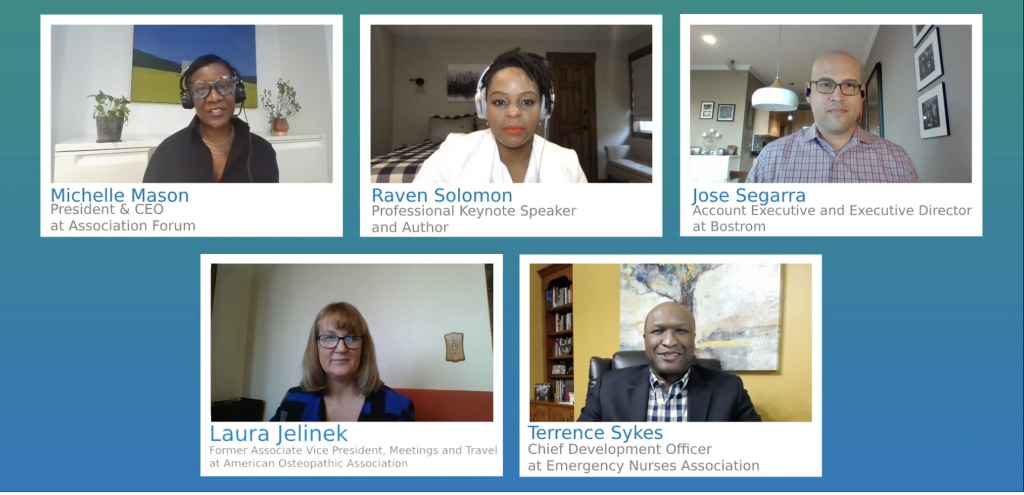MeetingMentor Magazine
How to Build an Inclusive Conference Environment
 Every conference should provide a sense of inclusivity and belonging where all feel welcomed and valued. But with an audience that spans multiple generations, races, sexual identities, and nationalities, all too often some members end up feeling out in the cold.
Every conference should provide a sense of inclusivity and belonging where all feel welcomed and valued. But with an audience that spans multiple generations, races, sexual identities, and nationalities, all too often some members end up feeling out in the cold.
In its continuing mission to foster diversity, equity and inclusion, ConferenceDirect capped its 2020 CDX event, held virtually in November, with a panel that addressed how to create content that makes everyone feel like they belong at the meeting. Led by Association Forum President and CEO Michelle Mason, the panelists who explored the topic included speaker and author Raven Solomon; Jose Segarra, an account executive and executive director at Bostrom; Laura Jeline, former associate vice president, meetings and travel at the American Osteopathic Association; and Terrence Sykes, chief development officer with the Emergency Nurses Association.
“We were fortunate to have Michelle Mason lead a great group of panelists through a conversation on creating content for a welcoming environment for a diverse audience,” said ConferenceDirect Executive Vice President/Chief Talent Officer Brian Richey. “We received great feedback on the session from our customers, partners and associates. ConferenceDirect looks forward to continued use of our platform to create more conversation, introduce best practices, etc., in the area of Diversity, Equity and Inclusion.”
To set the stage for the conversation, Solomon stressed the importance of understanding the diversity-related megatrends that are driving the business world, all of which provide a business case for all organizations to lean into the diversity conversation:
• A growing middle class in emerging markets that is shifting consumer demand, which will only increase the diversity of audiences as organizations position their business to take advantage of this growing consumer market.
• The increasing racial and ethnic diversity of Gen Z: “If there’s one thing I know about this generation, it’s the fact that they make buying decisions based on the things they care about. They vote with their dollars,” she said. “We need to be thinking about that.”
• The speed of innovation. “We know that the most innovative ideas come from diverse groups,” she said.
• An increasingly diverse talent pool: “Future success will depend on a leader’s ability to optimize that diverse talent pool.”
She also provided a framework all who want to create a more inclusive environment can use to ensure their efforts to create more inclusive events are intentional, impactful, and consistent. “When I see organizations trying to build this culture of inclusion and a welcoming environment, it starts with the idea of inclusive leadership,” she said. The six traits of intentional leadership she outlined are:
• Commitment: Before you begin to talk about content, you have to commit to wanting to provide an intentionally impactful experience for all participants, said one panelist. This is especially true for healthcare associations, because one of the determinants of health is race — for example, there’s a large disparity in the birth mortality rate between women of color and white women. It’s especially key for leadership to commit to diversity and inclusion so they can allow planners to create and execute in a different, more inclusive way. “It should align with your personal values, and also with the business case,” said Solomon.
And it should go beyond putting out a diversity and inclusion statement. One of the panelists talked about how their organization is reassessing everything through the lens of organizational biases, from certification processes to membership to conferences. “The statement is just the beginning, an acknowledgement of what’s going on,” said one panelist. “You also have to create some action behind that.”
• Courage. While not many like to talk about a soft skill like courage, if you’re going to be the one building content that is equitable and inclusive — and tasking others with making it happen — you will need to be courageous about it
• Cognizance of bias. It’s vital to recognize our own biases, to understand our own limitations, before trying to tackle inclusivity. And that goes for the organizational biases as well as the individual’s. A key question to dig into: How are we as an organization structured to benefit one group more than another? Courage then comes into play as individuals and organizations lean into fixing those biases.
• Curiosity. “It’s about having an open mindset and being willing to better understand how others experience the world,” said Solomon. That curiosity will build the understanding you’ll need to create content that expresses different viewpoints that exist in the world.
• Cultural intelligence. Also known as cultural quotient (CQ), this is the ability to relate and work effectively across cultures — which is only possible when the person or organization recognizes and understand the biases, including unconscious biases, that may be warping understanding of other cultures. And “culture” can be anything that shapes and defines how someone thinks, behaves, makes choices, and defines as “normal,” from place of origin to generation to race to profession to political orientation, etc.
• Collaboration. The ability to create a collaborative environment across different participation sectors is going to be key. The panelists talked about the importance of embracing diversity from the inside out, including creating task force committees comprised of the medical students and residents who will someday be the organization’s leaders. They also made a point of inviting diverse members to submit sessions, as well as partner with non-mainstream organizations that represent people of different racial and cultural backgrounds.
And don’t forget to bring your inclusivity mindset to your vendor interactions as well, they said. Just like Gen Z votes with their dollars, so does your organization when it chooses which vendors to work with.
 The bottom line is to find ways to build bridges instead of walls, said Mason. We need to find ways to not feel uncomfortable with asking the uncomfortable questions, such as the gender pronoun someone wants to be addressed by, said one panelist. And don’t forget that the conversation is not a one-and-done deal, but a continual discourse, said Solomon. “It starts with acknowledging that there’s a problem. Then start the conversation, knowing that your main role is to be the listener so you can gain perspective on the real lived experience of those in other groups.” Then educate yourself, and “take a bold outward stance to leverage your privilege in support of the marginalized group you are being an ally to,” she said.
The bottom line is to find ways to build bridges instead of walls, said Mason. We need to find ways to not feel uncomfortable with asking the uncomfortable questions, such as the gender pronoun someone wants to be addressed by, said one panelist. And don’t forget that the conversation is not a one-and-done deal, but a continual discourse, said Solomon. “It starts with acknowledging that there’s a problem. Then start the conversation, knowing that your main role is to be the listener so you can gain perspective on the real lived experience of those in other groups.” Then educate yourself, and “take a bold outward stance to leverage your privilege in support of the marginalized group you are being an ally to,” she said.
And don’t forget to measure the results and adjust accordingly, said another. Do the research and get the data, get the examples to bring to your board and committees. “We have a key opportunity in front of us,” said one panelist.
“We want that welcoming environment to be not just at our meetings, but all year long.” — Sue Pelletier
Free Subscription to
MeetingMentor Online
"*" indicates required fields
About ConferenceDirect
About MeetingMentor